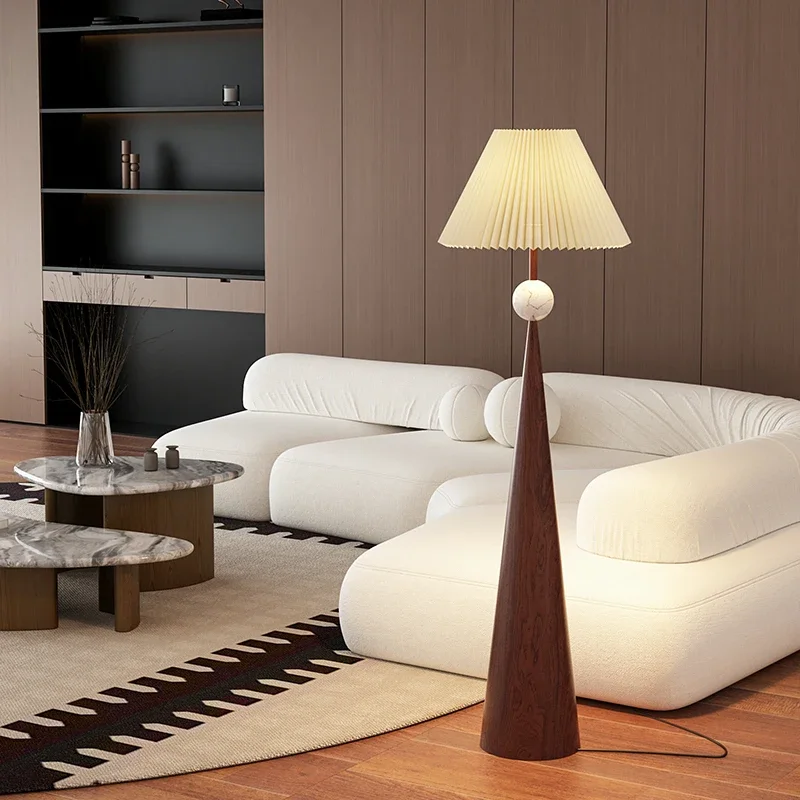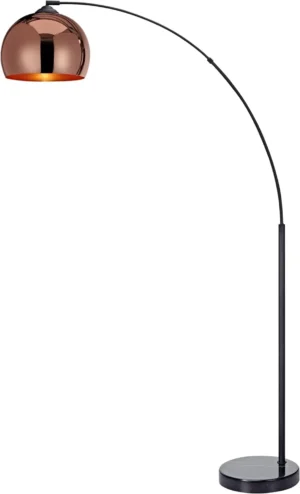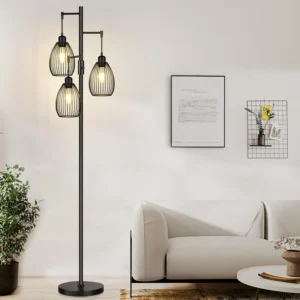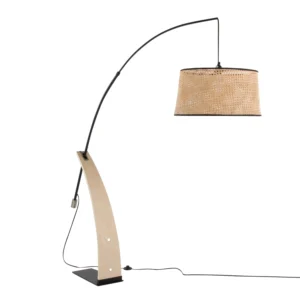Embracing Verticality: Why Oversized Arc Lamps Excel in High-Ceiling Rooms
High-ceiling spaces create an immediate sense of grandeur but present unique lighting challenges. The vast vertical expanse can leave rooms feeling cold or improperly illuminated when standard lighting solutions are applied. This is where oversized arc lamps come into their own, offering a perfect marriage of form and function for these impressive spaces.
Arc lamps have a rich design heritage dating back to the 1960s, when innovative designers first explored the dramatic curve that defines these striking fixtures. Today’s oversized versions build on this legacy, scaled specifically to address the proportional demands of tall ceilings. Unlike traditional floor lamps that direct light upward or downward in limited areas, oversized arc lamps project illumination across spaces with graceful, sweeping curves that complement architectural height.
What makes these lamps particularly effective in tall rooms is their ability to visually connect ceiling height with human-scale furnishings. The dramatic arc creates a visual pathway that draws the eye upward, celebrating rather than ignoring the room’s verticality. With luxury homes now commonly featuring ceilings of 10-15 feet or higher, these oversized fixtures fill a crucial design need.
Beyond mere illumination, these lamps serve as architectural elements in their own right. Their proportions respect fundamental design principles of scale and balance, preventing the disconnected feeling that often occurs when standard-sized lighting is placed in voluminous rooms. The best illuminating grand spaces with arc lamps demonstrates understanding of this critical relationship between ceiling height and lighting scale.
In the sections that follow, we’ll explore how these statement pieces transform tall spaces through their scale, proportion, light distribution, and aesthetic impact – turning the challenge of height into a design advantage.
Beyond Basic Illumination: Crafting a Statement Piece
Oversized arc lamps transcend basic lighting functionality to become sculptural elements that command attention. Their bold, sweeping forms create dynamic silhouettes against the vertical canvas of tall walls, introducing curved lines that dramatically contrast with the room’s angular architecture.
The visual impact of these lamps is partly rooted in their unexpected proportions. The exaggerated scale and gravity-defying arc create a sense of drama that standard lighting simply cannot match. Interior designers regularly utilize these characteristics to establish focal points in large rooms where visual anchoring is essential.
“Lighting should be treated as jewelry for the room,” notes a principle often cited in interior design circles. This concept is perfectly embodied in oversized arc lamps, where the curved metal arm becomes a piece of functional sculpture. The psychological effect is powerful – these lamps draw the eye, create visual interest, and establish a sense of thoughtful design intent within grand spaces.
High-profile installations in luxury hotels, designer showhouses, and architectural magazines frequently showcase these large arc lamp focal point applications. Their presence signals a sophisticated understanding of how lighting can transform from utility to art while still performing its essential function.
Mastering Scale and Proportion: Filling Expansive Volumes
The fundamental design principle that makes oversized arc lamps so effective is their appropriate scale relative to tall ceilings. In interior design, scale refers to an object’s size relative to its surroundings, while proportion addresses the relationship between parts of the same object.
Tall ceilings create expansive vertical volume that smaller lighting fixtures simply cannot address proportionally. This volume needs visual weight to feel balanced and intentional. When lighting is undersized, it appears disconnected from the space, creating an awkward imbalance that the eye immediately registers as problematic.
Designers typically recommend that lighting fixtures should be sized in proportion to the room dimensions. For tall ceilings, a general guideline suggests that the height of a floor lamp should be approximately 1/2 to 2/3 of the ceiling height to maintain proper visual weight. An oversized arc lamp with a height of 7-9 feet, therefore, creates harmonious proportion in rooms with 12-15 foot ceilings.
Common mistakes include selecting lamps that would look appropriate in standard-height rooms but become visually insignificant when placed in grand spaces. The difference is immediately apparent when properly scaled lighting is introduced – the room suddenly feels cohesive and intentionally designed. Understanding these ceiling height considerations for arc lamps is essential for successful implementation.
Broad Light Coverage for Open Spaces
One of the technical advantages oversized arc lamps offer is their superior light distribution pattern across large areas. Unlike traditional floor lamps that create concentrated pools of light, arc lamps project illumination from a higher point and at an angle that covers significantly more square footage.
This extended coverage is particularly valuable in open-concept spaces where ceiling-mounted fixtures might be impractical or insufficient. The arched design allows light to reach central areas of furniture groupings without requiring ceiling wiring, providing an elegant solution for rooms where architectural lighting is limited.
The light distribution pattern typically fans outward and downward from the shade, creating both ambient illumination and focused task lighting. Different shade designs affect this pattern – wider shades generally provide broader, softer light spread while narrower shades create more directed illumination.
When compared to recessed lighting or chandeliers, arc lamps offer the unique advantage of positioning light exactly where needed without permanent installation. This quality makes them particularly valuable in arc lighting solutions for high spaces where flexibility is desired.
Defining Zones and Anchoring Furniture
Beyond their illumination properties, oversized arc lamps excel at creating visual boundaries in open-concept spaces. As homes increasingly feature expansive multi-functional areas, these lamps serve as elegant zone definers that don’t require permanent walls or bulky furniture divisions.
The lamp’s arc naturally creates a canopy effect over seating arrangements, psychologically defining that area as a distinct zone. This subtle spatial organization helps large rooms feel more intentional and intimate despite their size. Designers frequently position arc lamps to anchor primary seating areas, creating a visual center around which conversation and activity naturally occur.
The relationship between lamp placement and furniture arrangement is symbiotic – each enhances the other’s purpose and visual impact. When properly positioned, an oversized arc lamp creates a sense of enclosure and intimacy within larger volumes, helping to overcome the potentially overwhelming scale of high-ceiling rooms.
This zoning function proves particularly effective in great rooms, lofts, and other open-plan spaces where traditional boundaries are absent but visual organization remains essential for comfortable living.
Choosing the Perfect Oversized Arc Lamp for Your Tall Ceiling
Selecting the ideal oversized arc lamp involves balancing technical specifications with aesthetic considerations. The perfect lamp for your space will meet both functional lighting requirements and enhance your interior design vision. Before making a selection, consider these key factors that will influence your lamp’s performance and appearance.
Your selection process should prioritize:
- Appropriate scale relative to your ceiling height
- Sufficient arc reach for your furniture arrangement
- Stable base design suitable for your flooring
- Light output matched to your room size and activities
- Adjustability features for versatile use
- Aesthetic compatibility with your décor style
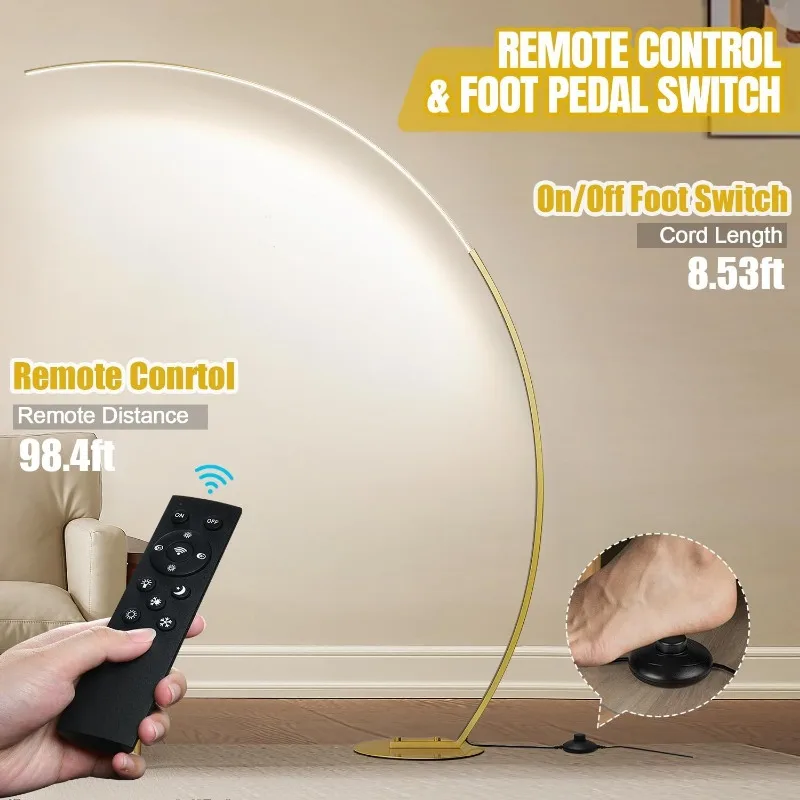
Each of these factors contributes to both the functionality and visual impact of your oversized arc lamp. The following sections will guide you through detailed considerations for each element, helping you identify the best arc lamps for tall ceilings for your specific space. Remember that the most successful lighting choices balance technical performance with design harmony.
Critical Dimensions: Lamp Height and Arc Reach
The most crucial measurements to consider when selecting an oversized arc lamp are its maximum height and horizontal reach. These dimensions determine both the lamp’s visual proportionality in your space and its functional lighting coverage.
For oversized arc lamps, height refers to the tallest point of the arched stem, typically ranging from 6 to 9 feet in larger models. Arc reach (sometimes called sweep or span) measures the horizontal distance from the base to the furthest extension of the shade, commonly 3 to 6 feet in oversized versions.
The relationship between these dimensions should be guided by:
- Ceiling height (determining appropriate lamp height)
- Furniture arrangement (determining necessary reach)
- Room size (ensuring proportional presence)
- Traffic flow (allowing comfortable clearance)
When measuring your space, account for both the lamp’s physical dimensions and its visual weight in the room. An appropriate oversized arc lamp should feel substantial but not overwhelming, reaching high enough to relate to the ceiling while remaining in human scale for practical use.
Interior Ivy’s collection of large oversized arc floor lamps offers various height and reach combinations to accommodate different ceiling heights and room configurations.
Matching Lamp Height to Ceiling Height: Expert Recommendations for 10ft, 12ft, and 15ft+ Ceilings
Selecting the correct lamp height relative to your ceiling height ensures proper proportion and visual balance. Follow these recommendations based on standard ceiling heights in grand spaces:
| Ceiling Height | Recommended Arc Lamp Height | Ideal Arc Reach | Visual Impact |
|---|---|---|---|
| 10 feet | 6 – 7 feet | 4 – 5 feet | Balanced presence without overwhelming |
| 12 feet | 7 – 8 feet | 5 – 6 feet | Substantial scale with comfortable clearance |
| 15+ feet | 8 – 9+ feet | 6+ feet | Dramatic statement proportional to grand height |
These recommendations follow the design principle that lighting fixtures in tall spaces should occupy approximately 1/2 to 2/3 of the vertical height to achieve proper visual weight. For extremely tall spaces (cathedral or double-height ceilings), even larger custom pieces may be appropriate.
Consider that the arc shape creates visual height beyond the actual measurement – the curved form draws the eye upward, enhancing the perception of height and connection to tall ceilings. When selecting a lamp for multi-story spaces like foyers, consider the viewing angles from different levels to ensure the lamp appears well-proportioned from all perspectives.
Understanding Arc Length: Illuminating Seating Areas and Beyond
The arc length determines how far your lamp’s light will reach into your space, affecting both its functionality and visual drama. This measurement is particularly important when planning lamp placement relative to furniture.
For effective furniture illumination, the center of your lamp shade should position approximately:
- 16-24 inches from the outer edge of sofas or sectionals
- 12-18 inches from the center of side chairs
- 26-30 inches above coffee tables or ottoman surfaces
The arc should extend far enough to position the light source where needed without requiring awkward base placement. For example, a sectional sofa might require an arc reach of 5-6 feet to position the light properly while keeping the base at a safe distance from traffic paths.
Interior Ivy’s large arc floor lamp collection offers various reach options to accommodate different furniture arrangements and room layouts. When measuring, remember to account for the diameter of the lamp shade, which typically extends the reach by 8-16 inches depending on the model.
Visualizing Impact: Space Planning and Diagrams
Before investing in an oversized arc lamp, visualizing its presence in your space helps ensure successful integration. Several approaches can help you accurately plan placement and evaluate proportions:
Create a simple floor plan marking furniture positions and potential lamp locations. Use a compass to draw arcs representing the lamp’s reach from different base positions.
Use masking tape on the floor to mark the base location and vertical string or painter’s tape on walls to visualize the height.
Employ digital tools like room planners or augmented reality apps that allow you to virtually place furniture and lighting in your space.
Create a height reference by temporarily extending a broomstick or measuring tape to the anticipated height of the lamp, helping visualize the vertical impact.
These visualization techniques help identify potential issues with clearance, proportion, or traffic flow before purchase. Consider viewing your plan from multiple angles, including seated positions, to ensure the lamp will function well from all perspectives.
Remember that photographs in catalogs can be deceiving about scale – always check actual measurements against your space dimensions for accurate visualization.
Shade Size and Design: Balancing Aesthetics and Function
The lamp shade is both a functional element controlling light distribution and a major design feature affecting the lamp’s overall appearance. Oversized arc lamps typically feature shades proportioned to balance their substantial frames, with diameters ranging from 14 to 24 inches depending on the model.
When evaluating shade design, consider these key factors:
- Size proportionality relative to arc dimensions and room scale
- Light direction (downward, ambient, or combination)
- Material translucency affecting light diffusion quality
- Visual weight in the overall lamp silhouette
- Style compatibility with your interior design
The shade represents the visual endpoint of the arc’s dramatic sweep, so its design significantly impacts the lamp’s statement quality. A well-designed shade should appear proportional to both the arc structure and the room itself, creating visual harmony.
Proportionate Shades for Grand Scale
For oversized arc lamps to maintain visual balance, shade diameter should increase proportionately with the lamp’s height and reach. This proportional relationship ensures the fixture appears coherent rather than top-heavy or undersized.
In rooms with ceilings 12 feet or higher, shade diameters of 18-24 inches create appropriate visual weight. For exceptionally tall spaces (15+ feet), even larger custom shades may be warranted. The shade should appear substantial enough to balance the dramatic arc without overwhelming the composition.
Visual weight is created through a combination of shade diameter, depth, and material density. A large but translucent shade may have less visual weight than a smaller shade in an opaque material. This balance affects how the lamp reads in the space – too small a shade can make even a tall lamp appear insubstantial, while an overly large shade may dominate inappropriately.
Interior Ivy’s collection of oversized arched floor lamp options features thoughtfully proportioned shades designed specifically for grand spaces and tall ceilings.
Light Diffusion and Direction: Up-lighting, Down-lighting, and Ambient Glow
The shade design determines not just the lamp’s appearance but also how light is distributed throughout your space. Different designs create distinctly different lighting effects:
- Downward-facing shades direct focused light onto surfaces below, ideal for reading areas or highlighting specific features
- Upward-facing shades bounce light off ceilings for soft, ambient illumination throughout the room
- Translucent drum shades provide a combination of downward task lighting and ambient glow
- Metal dome shades create dramatic directional light with minimal diffusion
- Open-top designs allow upward light to illuminate ceiling features while also directing light downward
Your lighting needs should guide your selection. Reading nooks and work areas benefit from directional downlighting, while conversational areas often work better with diffused ambient light. Some premium models offer adjustable shades that can be positioned for different lighting effects.
Consider that light quality changes with ceiling height – the higher the light source, the broader but less intense the illumination. Rooms with very tall ceilings may benefit from shades designed to maximize light projection.
Material Choices: Metal, Fabric, Rattan, and More
Shade materials significantly impact both light quality and aesthetic integration with your decor. Common materials for oversized arc lamp shades include:
- Fabric: Creates soft, diffused light; available in various opacities and colors; adds textural warmth
- Metal: Provides directed, focused light; offers clean contemporary lines; available in various finishes
- Glass: Creates clear, bright illumination; can be transparent, frosted, or colored
- Rattan/Natural Materials: Diffuses light through natural weaving; adds organic texture; creates interesting shadow patterns
- Paper/Parchment: Provides warm, even light diffusion; offers lightweight appearance; may require more frequent replacement
Each material affects not only the quality of light but also the lamp’s maintenance requirements and durability. Metal shades tend to be most durable but offer less light diffusion, while fabric shades provide softer illumination but may gather dust and require occasional cleaning.
When selecting shade material, consider both practical lighting needs and stylistic compatibility with your existing furnishings. The material should complement other design elements in the room while providing appropriate light for your activities.
Base Stability and Weight: A Foundation for Safety and Grandeur
The base of an oversized arc lamp serves dual critical functions: providing necessary counterbalance for the extended arm and contributing to the lamp’s overall aesthetic. This component requires particular attention when selecting a lamp for tall ceilings, as longer arcs necessitate more substantial bases.
A properly designed base should:
- Provide sufficient counterweight to prevent tipping
- Maintain stability on various flooring surfaces
- Integrate harmoniously with the overall design
- Allow for placement that balances visual impact and practicality
- Minimize tripping hazards through thoughtful design
For oversized models, base weight typically ranges from 25 to 45 pounds, with heavier bases corresponding to longer arc extensions. This substantial weight ensures stability but also requires consideration for flooring protection and occasional repositioning needs.
Ensuring Steadfast Support for Towering Structures
The physics of arc lamp design requires careful engineering to balance the extended cantilever of the arm against the counterweight of the base. This balance becomes increasingly critical as lamp heights increase for tall ceilings.
Properly engineered oversized arc lamps incorporate:
- Weighted base materials (marble, steel, concrete)
- Low center of gravity design
- Wide footprint for stability
- Reinforced connection points between base and stem
- Quality materials that maintain structural integrity over time
Warning signs of inadequate support structure include wobbling when the shade is adjusted, base lifting slightly when the arm is fully extended, or connections that seem stressed under normal use. These indicators suggest the lamp may not be properly designed for its size.
For homes with active children, pets, or high traffic areas, preventing arc lamps from tipping is especially important. Some models incorporate additional safety features like wider base footprints or the ability to secure the base to flooring with discreet mechanisms.
Weighted Bases and Footprint Considerations
The base footprint – the amount of floor space occupied by the lamp base – varies considerably among oversized arc lamp designs. Standard measurements range from 12×12 inches for smaller models to 18×18 inches or larger for truly oversized pieces designed for very tall ceilings.
When planning lamp placement, consider:
- Floor space required for the base (typically square or round)
- Clearance needed around the base for traffic flow
- Visual impact of the base material and design
- Relationship between base position and light placement
- Protection needed for delicate flooring
Some contemporary designs attempt to minimize visual footprint while maintaining necessary weight through innovative shapes or heavier materials. Others celebrate the base as a design feature, using materials like polished marble or sculptural forms that enhance the lamp’s presence.
Interior Ivy’s marble base arc floor lamp collection offers elegant stability solutions that combine proper weighting with aesthetic refinement, proving that functional elements can also be beautiful design features.
Optimal Light Output (Lumens) for Large Volumes
The light output required for tall ceiling spaces differs significantly from standard-height rooms. The increased volume and distance between light source and surfaces means higher lumen output is typically necessary for effective illumination.
Lumens measure the total amount of visible light emitted by a source, with higher numbers indicating brighter light. For non-technical consumers, understanding lumen requirements helps ensure your oversized arc lamp will provide adequate illumination for your space.
As a general guideline, rooms with tall ceilings require approximately:
– 10-foot ceilings: 1,500-2,500 lumens
– 12-foot ceilings: 2,000-3,000 lumens
– 15+ foot ceilings: 2,500-4,000+ lumens
These ranges assume the arc lamp serves as a significant light source rather than purely decorative accent lighting. The actual perception of brightness will be affected by ceiling color, wall reflectivity, and other ambient light sources in the room.
Calculating Lumens Needed for High-Ceiling Rooms
To determine appropriate lumen output for your specific space, use this simplified calculation method:
- Multiply your room’s square footage by 20 for bright task lighting or 10 for ambient lighting
- For ceilings above 8 feet, add 10% for each additional foot of height
- Consider room colors (add 10% for dark colors, subtract 10% for very light colors)
Example calculation for a 200-square-foot room with 12-foot ceilings and medium-toned walls:
– Base lumens: 200 × 15 (medium brightness) = 3,000 lumens
– Ceiling height adjustment: 40% more (4 feet above standard) = 1,200 additional lumens
– Total recommended: 4,200 lumens
Remember that this represents the total recommended light for the room, not necessarily from a single source. If your arc lamp is one of several light sources, adjust accordingly. Most quality oversized arc lamps accommodate bulbs or integrated LEDs producing 800-2,500 lumens, depending on the model.
Dimmable Features for Versatile Ambiance
Dimmability is particularly valuable for oversized statement lamps, allowing adjustment from bright task lighting to subtle ambient illumination. This feature extends the lamp’s versatility across different activities and times of day.
Benefits of dimmable oversized arc lamps include:
- Adjusting brightness for different activities (reading, entertaining, relaxing)
- Creating varied moods and atmospheres
- Energy savings when full brightness isn’t needed
- Extended bulb life through reduced power consumption
- Flexibility to coordinate with other lighting sources
Modern dimming technologies include integrated dimmer switches on the cord, compatibility with wall dimmers, or smart controls that work with home automation systems. When selecting a dimmable lamp, ensure compatibility between the dimmer mechanism and your chosen bulb type to avoid flickering or humming.
Interior Ivy’s dimmable arc floor lamp options provide smooth dimming capabilities that transform lighting from functional to atmospheric with simple adjustment.
Energy-Efficient LED Options
LED technology has revolutionized lighting options for oversized arc lamps, offering significant advantages over traditional incandescent or halogen bulbs. These benefits are particularly relevant for tall ceiling applications where bulb changing can be challenging.
| Bulb Type | Average Lifespan | Energy Consumption | Heat Output | Color Options |
|---|---|---|---|---|
| LED | 25,000+ hours | 9-15 watts | Minimal | Wide range (2700K-5000K) |
| Halogen | 2,000 hours | 45-60 watts | High | Limited (2800-3000K) |
| Incandescent | 1,200 hours | 60-100 watts | Very high | Limited (2700K) |
For a typical oversized arc lamp used 4 hours daily, an LED bulb might last over 17 years before replacement, compared to less than 2 years for halogen alternatives. This longevity is particularly valuable for tall ceiling applications where changing bulbs can be cumbersome.
Modern LEDs also offer excellent color rendering and temperature options, from warm ambient light (2700-3000K) to cooler, more energizing illumination (3500-5000K). Many high-quality oversized arc lamps now feature integrated LED panels rather than replaceable bulbs, providing seamless design and consistent light quality.
Adjustability and Versatility
The ability to adjust an oversized arc lamp enhances its functionality and longevity in your space. As furniture arrangements change or different activities require varied lighting, adjustable features allow the lamp to remain perfectly positioned for optimal effect.
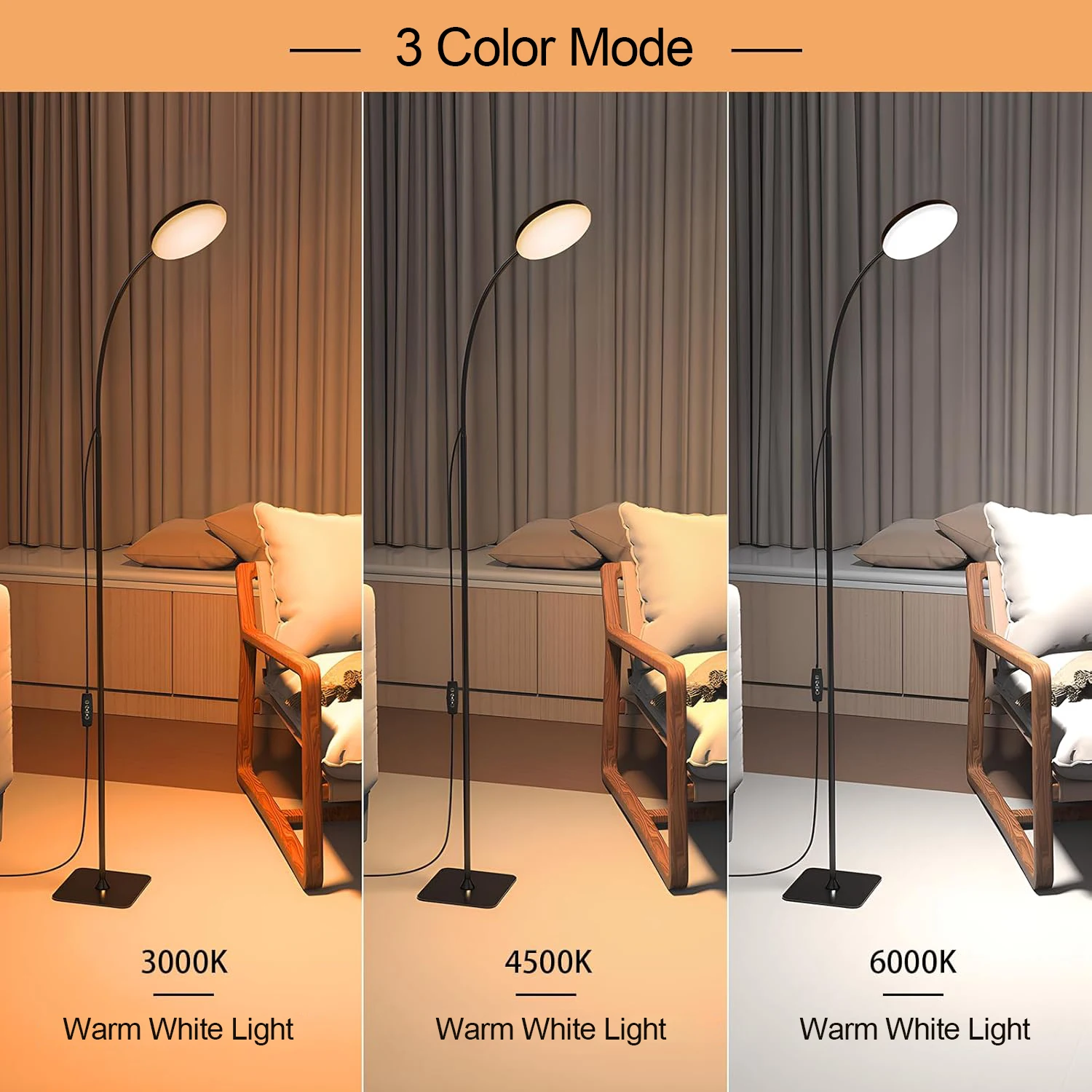
Key adjustability features to consider include:
- Height adjustment capability
- Arm extension or retraction options
- Shade angle adjustability
- Swivel or rotation at key connection points
- Dimming functionality for light control
While more adjustment points generally offer greater versatility, they may also introduce more mechanical parts that could wear over time. Quality engineering and materials in the adjustment mechanisms ensure smooth operation and durability through years of use.
Telescoping Poles and Articulating Arms
Height-adjustable arc lamps feature mechanisms that allow vertical extension or retraction of the main pole. This feature is particularly valuable for adaptability to different ceiling heights or changing the light’s position for various activities.
Common adjustment mechanisms include:
- Telescoping poles that extend through internal sliding sections
- Segmented arms with adjustable joints and locking mechanisms
- Height-adjustment rings or collars that secure at various positions
- Counterbalanced systems that maintain stability at different heights
Quality adjustable lamps maintain visual elegance despite their mechanical functionality. The adjustment range typically spans 6-18 inches in height variation, though some premium models offer greater range. When evaluating these features, test the smoothness of operation and stability at various positions.
The ultimate guide to adjustable arc lamps highlights how these versatile features enhance functionality without compromising aesthetic impact. Look for adjustment mechanisms that operate smoothly and lock securely to maintain your preferred position.
Swiveling Shades for Targeted Illumination
Shade adjustability adds another dimension of versatility, allowing directional control of light beyond the arc’s fixed position. This feature transforms the lamp from general ambient lighting to focused task illumination for specific activities.
Swiveling shade mechanisms typically offer:
- 180-degree vertical rotation for directing light up or down
- 350-degree horizontal rotation to target specific areas
- Tension adjustment to maintain position without drifting
- Easy grip points for adjustment without touching hot surfaces
This directional control proves particularly valuable for reading areas, artwork highlighting, or creating dramatic wall-washing effects. When multiple activities occur in a single space, adjustable shades allow light to be redirected rather than requiring lamp repositioning.
When evaluating shade adjustability, check that mechanisms move smoothly but maintain position when set. Quality designs incorporate heat-resistant materials at adjustment points to prevent warping or weakening over time.
Adapting to Changing Room Layouts
One of the significant advantages of oversized arc lamps compared to fixed lighting is their ability to adapt as your space evolves. This adaptability ensures continued relevance through furniture rearrangements, room repurposing, or changing household needs.
Strategies for maximizing adaptability include:
- Selecting models with multiple adjustment features
- Choosing neutral finishes that complement various color schemes
- Opting for classic designs that transcend short-term trends
- Considering base designs that work with different flooring types
- Selecting light output suitable for various activities
Many Interior Ivy customers report that their adjustable arc lamps have remained central design elements through multiple room reconfigurations, highlighting the long-term value of versatile lighting solutions. This adaptability makes quality arc lamps a wise investment despite their higher initial cost compared to fixed lighting options.
Contemporary Arc Floor Lamp, Large Arc Floor Lamp, Marble Base Arc Floor Lamp
$224.94 Select options This product has multiple variants. The options may be chosen on the product pageMid-Century Arc Floor Lamp, Wood Arc Floor Lamp
$230.86 Select options This product has multiple variants. The options may be chosen on the product page- $1,003.85 Select options This product has multiple variants. The options may be chosen on the product page
3 Light Arc Floor Lamp, Dimmable Arc Floor Lamp
Price range: $162.86 through $246.50 Select options This product has multiple variants. The options may be chosen on the product pageBlack Arc Floor Lamp, Mid-Century Arc Floor Lamp, Rattan Arc Floor Lamp, Wood Arc Floor Lamp
$963.46 Select options This product has multiple variants. The options may be chosen on the product pageChrome Arc Floor Lamp, Dimmable Arc Floor Lamp, Gold Arc Floor Lamp, LED Arc Floor Lamp
Price range: $623.49 through $2,417.47 Select options This product has multiple variants. The options may be chosen on the product page
Strategic Placement: Maximizing Impact in High-Ceiling Environments
The transformative potential of an oversized arc lamp depends significantly on its placement within your space. Strategic positioning enhances both the lamp’s visual impact and its functional lighting benefits, creating a harmonious relationship with architecture and furnishings.
Effective placement requires balancing several considerations:
- Visual prominence as a design statement
- Practical illumination for daily activities
- Traffic flow and clearance requirements
- Relationship to other design elements
- Balance with room proportions and layout
Avoid common placement mistakes like positioning that creates awkward traffic patterns, insufficient clearance height, or placement that competes with rather than complements other focal points. The most successful installations feel intentional but not forced, creating natural focal points that enhance the room’s overall design.
For rooms with particularly challenging dimensions or layouts, lighting high ceiling rooms with arc lamps requires thoughtful planning to achieve optimal results. The following sections outline specific placement strategies for common scenarios in grand spaces.
Behind Sectionals and Sofas: Creating Intimate Conversational Zones
One of the most effective placements for oversized arc lamps is behind seating areas, where the arching form creates a canopy effect over the conversation zone. This positioning creates both visual anchor and functional task lighting for the seating area.
For optimal placement behind sofas or sectionals:
- Position the base 12-18 inches behind the sofa back
- Center the base on the main seating section or slightly off-center for visual interest
- Adjust the arc so the shade hangs 26-30 inches above the coffee table surface
- Ensure the shade position allows light to fall where reading or other activities occur
- Verify at least 7 feet of clearance beneath the highest part of the arc for comfortable movement
This placement creates a natural boundary for the seating area while keeping the substantial base safely out of traffic patterns. The arching form visually connects the vertical wall space to the horizontal seating plane, creating a cohesive composition that feels intentional and inviting.
Over Dining Tables: A Dramatic and Functional Focal Point
Oversized arc lamps create striking dining room lighting solutions that avoid the permanence of hardwired fixtures while providing necessary task illumination. This application works particularly well in open-concept spaces where traditional ceiling-centered fixtures might not align with flexible dining arrangements.
For dining table placement:
- Position the base 24-30 inches from the table edge
- Center the lamp shade over the table’s center point
- Adjust height so the bottom of the shade hangs 30-36 inches above the table surface
- Ensure the arc clears the heads of seated diners by at least 12 inches
- Consider table shape – round tables pair beautifully with the curved arc form
The dramatic sweep creates a defined dining zone within larger spaces while the proper height ensures diners can see each other without visual obstruction. For expandable tables, choose a lamp position that accommodates the table’s largest configuration or select an adjustable model that can adapt to changing dimensions.
Defining Open-Concept Spaces: Visual Separation and Flow
In expansive open-concept areas, oversized arc lamps excel at creating visual boundaries between functional zones without physical barriers. This zoning technique maintains spaciousness while providing organization and purpose to different areas.
Effective zoning strategies include:
- Positioning arc lamps at transition points between functional areas
- Using the lamp’s arc to frame entry into a specific zone
- Aligning the base with architectural features that suggest boundaries
- Creating lighting patterns that define activity areas
- Coordinating with area rugs and furniture groupings to reinforce zones
When using multiple arc lamps in open spaces, maintain visual cohesion through consistent finishes or complementary designs while varying heights or styles slightly for interest. The lamps should create a rhythm through the space rather than competing for attention.
This approach proves particularly valuable in lofts, great rooms, or converted industrial spaces where architectural divisions are minimal but functional organization remains essential.
Accentuating Architectural Features: Walls, Fireplaces, and Art
Oversized arc lamps can direct attention to architectural elements and art pieces, enhancing their presence within tall spaces. The lamp itself creates a visual dialogue with these features, each elevating the other’s impact.
For highlighting architectural elements:
- Position the lamp to create a visual relationship with the feature
- Use the curve of the arc to echo architectural lines or provide contrasting forms
- Select directional shades that cast light appropriately on the featured element
- Consider how both daylight and evening lighting affect the composition
- Balance the visual weight of the lamp with the highlighted feature
This technique works particularly well with fireplace walls, built-in bookshelves, textural wall treatments, or significant art installations. The lamp simultaneously draws attention to these features while providing necessary illumination to appreciate their details.
Reading Nooks and Lounge Areas: Task Lighting with Flair
Personal retreats within larger spaces benefit tremendously from the focused illumination and intimate scale created by arc lamps. Reading corners, in particular, require specific light positioning that oversized arc designs can deliver with both function and style.
For optimal reading light placement:
- Position the base beside or slightly behind the reading chair
- Adjust the arc so the shade directs light over the reader’s shoulder
- Set height to bring the light source 16-20 inches from reading material
- Ensure the light falls on pages without creating glare or shadow
- Allow clearance for comfortable movement in and out of the seating
The perfect arc lamp reading nook combines comfortable seating, accessible side surfaces, and precisely positioned lighting that reduces eye strain while creating a cozy atmosphere. Adjustable models prove particularly valuable for reading applications, as they can be fine-tuned to individual preferences and various reading positions.
Clearance and Walkway Considerations: Safety and Aesthetics
While aesthetic impact drives many placement decisions, practical clearance requirements remain essential for both safety and comfortable navigation through spaces. Oversized arc lamps must be positioned with careful attention to movement patterns and overhead clearance.
Minimum clearance guidelines include:
- Maintain at least 7 feet from floor to lowest point of the arc in walkways
- Allow 30-36 inches of clear space around the base in traffic areas
- Position cords away from pathways or secure them appropriately
- Consider door swing paths and ensure the lamp doesn’t obstruct openings
- Account for occasional rearrangement needs in clearance planning
For homes with varying user heights, adjustable models allow customization to accommodate taller family members or guests. When planning placement near stairs, entries, or other transition zones, prioritize generous clearance to prevent accidents during distracted or hurried movements.
Design Styles: Integrating Oversized Arc Lamps with Your Decor
Oversized arc lamps appear across diverse interior design styles, from minimalist modern to richly textured traditional spaces. Their versatility stems from the fundamental elegance of the arching form combined with endless material and finish variations that can complement any aesthetic direction.
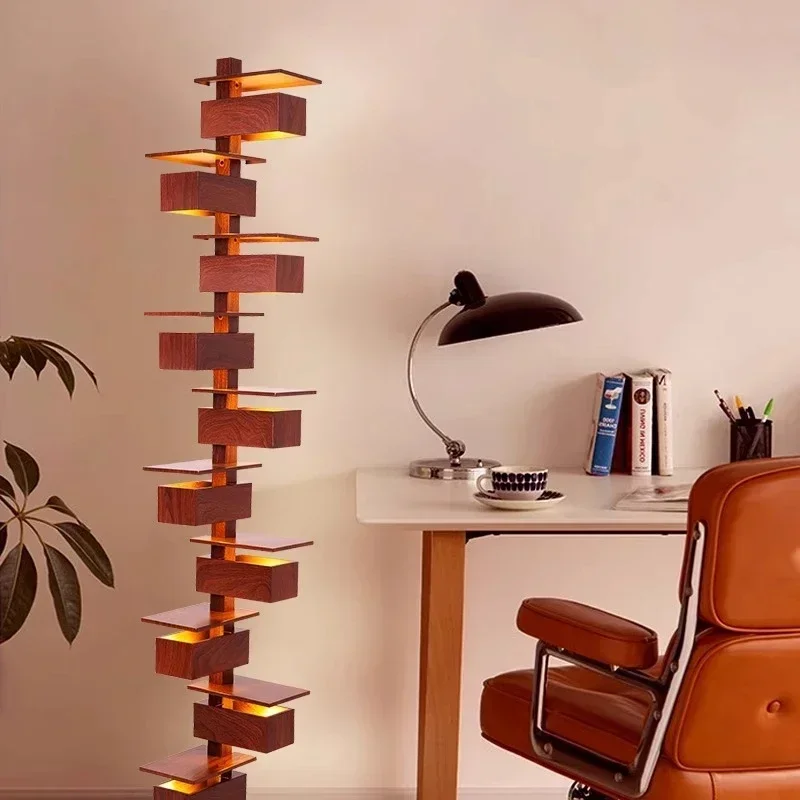
When integrating these statement pieces with your existing décor, consider:
- The lamp’s materials and how they relate to other elements in the room
- Finish compatibility with your overall color scheme
- The visual weight of the lamp relative to other furniture
- Style language shared between the lamp and major pieces
- Historical context and references in your design scheme
Designer insights suggest that oversized arc lamps work most successfully when they either clearly complement the dominant style or provide an intentional counterpoint that creates tension and interest. Either approach requires understanding the lamp’s design heritage and how it communicates within the larger context of your interior.
Mid-Century Modern Icons: Timeless Curves and Bold Statements
The arc lamp’s design heritage is firmly rooted in mid-century modernism, when innovative designers first explored the dramatic cantilever form that defines these fixtures. Contemporary oversized versions continue to reference these origins while adapting to current scale preferences.
Characteristic elements of mid-century arc lamps include:
- Clean, continuous curves without ornate details
- Combination of materials like marble bases with metal stems
- Drum or dome-shaped shades with simple profiles
- Focus on function expressed through form
- Balance of visual lightness and physical stability
Influential mid-century designs like the Arco lamp (created by Achille and Pier Giacomo Castiglioni) established design principles that continue to inspire contemporary interpretations. These classic forms pair naturally with other mid-century furnishings but also create effective contrasts in contemporary settings.
Interior Ivy’s mid-century arc floor lamp collection honors these design traditions while incorporating modern engineering and materials for enhanced durability and performance.
Sleek Contemporary Designs: Minimalist Forms and Clean Lines
Contemporary interpretations of arc lamps emphasize simplified forms, technological integration, and material innovations. These designs typically feature:
- Reduced structural elements with emphasis on essential form
- Monochromatic or limited color palettes
- Integrated LED technology replacing traditional bulbs
- Minimal visible hardware or connections
- Emphasis on negative space within the design
These sleek interpretations complement modern interiors with their focus on clean lines and uncluttered compositions. They particularly excel in spaces with architectural minimalism, where the lamp’s sculptural form provides necessary visual interest without excessive detail.
Contemporary arc lamps often incorporate advanced engineering that reduces the visual weight of components while maintaining necessary stability. Innovative materials like carbon fiber, aircraft-grade aluminum, or advanced composites enable thinner profiles and more dramatic proportions than traditional materials allow.
Industrial Edge: Exposed Materials and Utilitarian Chic
Industrial-inspired arc lamps embrace raw materials and visible mechanics as design features rather than elements to conceal. This aesthetic celebrates:
- Exposed hardware and adjustment mechanisms
- Raw or minimally finished metal surfaces
- Mechanical elements as decorative features
- Contrast between refined forms and utilitarian details
- Reference to workshop and factory lighting traditions
These designs particularly complement spaces with industrial architectural elements like exposed brick, concrete surfaces, visible ductwork, or repurposed commercial spaces. The substantial scale of oversized industrial arc lamps stands up effectively to these robust architectural features.
Material treatments might include distressed finishes, patinated metals, or intentionally rough textures that add character and suggest history. Despite their industrial aesthetic, these lamps maintain sophisticated engineering and stability required for their oversized proportions.
Transitional Versatility: Blending Classic and Modern Elements
Transitional arc lamps bridge traditional and contemporary design elements, offering remarkable versatility for evolving interiors. These balanced designs feature:
- Classic proportions with updated materials
- Subtle detailing that adds interest without overwhelming
- Refined finishes that complement both traditional and modern elements
- Familiar forms executed with contemporary engineering
- Adaptable styling that works across design contexts
This middle-ground approach works particularly well in homes that mix furniture periods or in spaces undergoing gradual style evolution. Transitional arc lamps avoid strong period references in favor of timeless elements that coordinate easily with diverse furnishings.
The adaptability of transitional designs makes them excellent investment pieces that remain relevant through redecorating cycles. Their balanced aesthetic typically incorporates enough traditional elements for warmth while maintaining the clean lines associated with contemporary design.
Material Pairing: Wood, Marble, Brass, Steel, and Fabrics
The materials used in oversized arc lamps significantly influence how they interact with your existing décor. Thoughtful material pairing creates cohesion and enhances the lamp’s integration with your interior design vision.
Effective material pairings include:
- Marble bases with brass stems – Adds warmth and luxury, complements traditional and transitional interiors
- Blackened steel with linen shades – Creates contemporary contrast with softened edges
- Wood elements with brushed metals – Brings organic warmth to modern forms
- Polished chrome with glass – Maximizes reflectivity and light, suits minimalist spaces
- Bronze finishes with textured fabric shades – Adds richness and depth for traditional settings
When selecting materials, consider both aesthetic harmony and practical maintenance requirements. Some high-impact combinations like polished marble and brass create stunning visual appeal but require more regular cleaning to maintain their appearance.
Material choices should establish connections with other elements in your space – perhaps echoing wood tones from architectural features, matching metal finishes from hardware, or complementing fabric textures from upholstery. These thoughtful connections create a cohesive design that feels intentionally curated rather than randomly assembled.
Installation and Care: Ensuring Longevity and Safety
Proper installation and maintenance of oversized arc lamps ensures both safety and lasting performance. While these substantial fixtures create dramatic visual impact, their size also requires special attention to stability, assembly, and ongoing care.
Key considerations for long-term satisfaction include:
- Proper assembly following manufacturer guidelines
- Secure positioning appropriate to your flooring type
- Regular maintenance based on specific materials
- Safe electrical practices for operation and bulb replacement
- Appropriate cleaning techniques for different finishes
Taking time for correct initial setup and establishing regular maintenance routines protects your investment and ensures your oversized arc lamp remains both beautiful and functional for years to come. The following sections provide specific guidance for each aspect of installation and care.
Assembling Your Oversized Arc Lamp: Step-by-Step Guide
Most oversized arc lamps ship partially disassembled to protect components during transport. While specific assembly varies by model, these general steps apply to most designs:
Prepare the space: Clear adequate floor area for assembly, ideally near the lamp’s final position. Lay out all parts and confirm all components are included.
Assemble the base: Connect base components according to manufacturer instructions. For weighted bases with internal ballast, ensure weight is properly secured before proceeding.
Attach the vertical pole: Connect the main support pole to the base, ensuring connections are tight and the pole stands perfectly vertical.
Connect the arc section: Attach the curved arm to the main pole, following alignment guides in the instructions. This often requires two people for larger models.
Secure all connections: Double-check and tighten all fasteners, ensuring there is no wobble or movement at connection points.
Attach the shade assembly: Connect the light socket and shade components, ensuring electrical connections are secure and shade is properly aligned.
Install recommended bulb: Select appropriate bulb type and wattage as specified by the manufacturer.
Test stability: Gently test the assembled lamp for stability before positioning in its final location.
Estimated assembly time ranges from 30-60 minutes depending on lamp complexity. Having a helper for larger models significantly eases the process, particularly when attaching the arc section to the base assembly.
Securing Placement: Tips for Stability on Various Flooring
Different flooring surfaces present unique challenges for oversized arc lamp stability. Addressing these specific requirements ensures safe operation and prevents damage to both the lamp and your floors.
For carpet and rugs:
– Use a hard floor plate beneath the base to prevent sinking and tilting
– Consider carpet grippers on the base underside for additional stability
– Choose wider base designs that distribute weight more effectively
For hardwood and laminate:
– Add protective felt or furniture pads to prevent scratching
– Use non-slip mats beneath the base if the surface is particularly smooth
– Consider floor-safe adhesive options for households with active children or pets
For tile and stone:
– Use rubber or silicone pads to prevent slipping on smooth surfaces
– Check for uneven grout lines that might affect base stability
– Consider clear silicon corner guards if positioned near edges
For sloped or slightly uneven surfaces:
– Use adjustable levelers or shims to create a perfectly level base
– Select models with built-in leveling features if floor irregularities are common
– Check stability regularly as flooring may settle or shift over time
Cord Management: Hiding Wires for a Polished Look
The visual impact of an oversized arc lamp can be diminished by visible power cords. Thoughtful cord management maintains the lamp’s clean aesthetic while ensuring safe electrical connections.
Effective cord management strategies include:
- Route cords along furniture edges or room perimeters where they’re less visible
- Use cord covers in coordinating colors to blend with flooring or walls
- Consider cord channels that can be painted to match wall colors
- Secure cords with adhesive clips to maintain clean routing
- Position the lamp near outlets to minimize cord length when possible
For permanent installations, consider floor outlet installation directly beneath the lamp base – an excellent solution for open floor plans where the lamp sits away from walls. Alternatively, professional electricians can install recessed wall outlets at appropriate heights to minimize visible cord.
Product solutions like flat extension cords, decorative cord covers, or braided cord sleeves can transform utilitarian power cords into design elements that complement rather than detract from your lamp’s appearance.
Cleaning and Maintenance for Lasting Brilliance
Regular maintenance preserves both appearance and functionality of your oversized arc lamp. Different materials require specific cleaning approaches:
For metal components:
– Chrome/stainless steel: Wipe with microfiber cloth and glass cleaner
– Brass/copper: Apply appropriate metal polish, following with microfiber buffing
– Matte finishes: Dust regularly with soft cloth, clean with mild soap solution when needed
– Avoid abrasive cleaners on any metal finish
For stone bases:
– Marble: Clean with stone-specific products, avoid acidic cleaners
– Concrete: Dust regularly, clean with pH-neutral soap when needed
– Seal natural stone bases annually to prevent staining
For fabric shades:
– Vacuum gently with upholstery attachment
– Spot clean with mild soap and water
– Remove dust regularly to prevent discoloration
– Consider professional cleaning for persistent stains
Establish a quarterly deep cleaning schedule while dusting accessible components weekly. Address fingerprints or smudges on high-touch areas like switches or adjustment points immediately to prevent buildup that becomes difficult to remove.
Bulb Replacement and Compatibility
Selecting appropriate replacement bulbs ensures optimal performance and prevents damage to your lamp. Always consult your lamp’s specifications for maximum supported wattage and bulb type recommendations.
Common compatibility considerations include:
- Socket type (E26/E27 medium base is most common in oversized lamps)
- Maximum wattage rating (typically 60-100W equivalent)
- Physical size constraints within the shade
- Dimmer compatibility if applicable
- Color temperature preference (2700K-3000K for warm light, 3500K-4000K for neutral)
For LED replacements in older lamps, check both base compatibility and dimensional fit, as some LED bulbs have larger profiles than traditional incandescents. Dimmable lamps require specifically labeled dimmable bulbs to prevent flickering or premature failure.
When replacing bulbs, ensure the lamp is unplugged and any previous bulb has cooled completely. Handle new bulbs with clean hands or gloves, as skin oils can create hot spots on some bulb types that reduce lifespan.
Frequently Asked Questions About Oversized Arc Lamps and Tall Ceilings
Selecting and placing oversized arc lamps for tall ceilings raises common questions from homeowners and designers alike. These practical answers address the most frequent concerns and provide quick guidance for successful implementation.
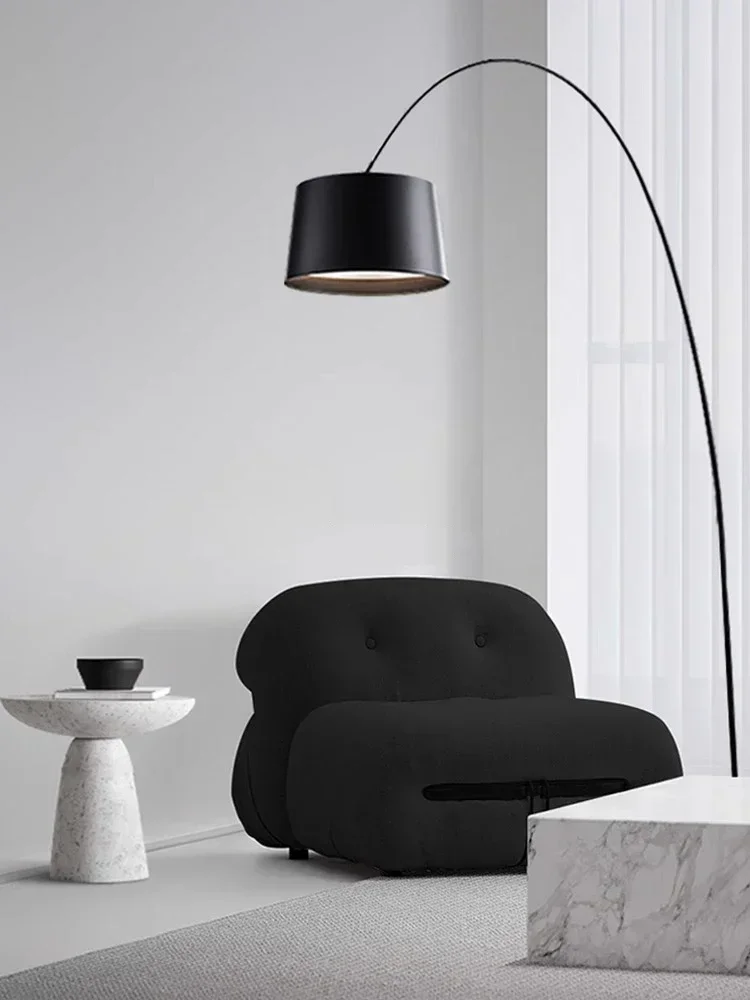
How tall should my arc lamp be for a 15-foot ceiling?
For a 15-foot ceiling, select an arc lamp between 8-10 feet in height to maintain proper proportion. This height range (approximately 2/3 of ceiling height) creates visual balance while maintaining comfortable clearance for movement. Consider adjustable-height models that allow fine-tuning for your specific space.
The exact height should also account for furniture scale and room dimensions. Larger rooms with substantial furniture may support lamps at the higher end of this range, while smaller spaces might benefit from slightly shorter options. When reviewing tall arc floor lamps for vaulted ceilings, prioritize models with proportions specifically designed for grand vertical spaces.
Can an arc lamp provide enough light for an entire large room?
While oversized arc lamps provide significant illumination, they typically cannot adequately light an entire large room as the sole light source. They excel as primary lighting for specific zones (seating areas, reading nooks, dining spaces) but work best as part of a layered lighting plan.
For complete room illumination, complement your arc lamp with:
– Ceiling fixtures for overall ambient light
– Additional task lighting for specific activity areas
– Accent lighting to highlight architectural features
– Wall sconces or table lamps for balanced light distribution
Strategic lamp placement maximizes coverage, but expect to illuminate approximately 100-150 square feet effectively from a single oversized arc lamp with standard bulb wattage.
Are oversized arc lamps stable and safe, especially with children or pets?
Quality oversized arc lamps are engineered for stability when properly assembled and positioned. Their heavy bases (typically 25-45 pounds) provide necessary counterbalance for the extended arm. However, additional precautions are advisable for households with children or active pets:
- Select models with extra-wide bases for improved stability
- Consider marble or stone-based options for maximum weight
- Position bases away from high-traffic paths
- Secure cords to prevent tripping or pulling
- Consider additional securing methods like furniture anchors for households with climbing children
With proper selection and placement, oversized arc lamps pose minimal tipping risk during normal use, though impact from running or climbing remains a consideration for family homes.
How do you move or adjust a very large arc lamp?
Moving an oversized arc lamp requires careful handling to protect both the lamp and your space:
- Remove the bulb if accessible and safely stored
- Identify natural grip points on the base and stem (never carry by the shade or thinnest sections)
- Have two adults lift the lamp – one handling the base, the other supporting the arc
- Lift vertically before moving horizontally to avoid stress on connections
- Use furniture sliders under the base for short repositioning across floors
For height or arc adjustments, follow manufacturer guidelines for your specific model. Most require loosening adjustment knobs or collars, making the position change while supporting the weight of the extended section, then re-tightening securely. Never force adjustment mechanisms, as this can damage internal components.
What’s the difference between an oversized arc lamp and a regular floor lamp?
Oversized arc lamps differ from standard floor lamps in several key aspects:
- Height: Oversized arc lamps typically stand 6-9 feet tall versus 5-6 feet for standard floor lamps
- Reach: Arc lamps extend 3-6 feet horizontally while traditional floor lamps remain vertical
- Light positioning: Arc lamps project light from above and across spaces versus the more limited downward or upward light of traditional designs
- Visual impact: Arc lamps create dramatic sculptural presence versus the more utilitarian profile of standard options
- Base design: Arc lamps require substantial weighted bases versus the lighter bases of traditional floor lamps
These differences make oversized arc lamps more suitable for defining spaces, creating architectural interest, and properly scaling to tall ceilings – functions that standard floor lamps cannot fulfill effectively.
Can I use an oversized arc lamp in a room with a sloped or vaulted ceiling?
Sloped and vaulted ceilings pair beautifully with oversized arc lamps, often creating dramatic visual dialogue between the curved lamp form and angular ceiling planes. When using arc lamps in these spaces:
- Position the lamp perpendicular to the slope direction for maximum visual impact
- Consider how the arc relates to the ceiling angle – parallel, contrasting, or complementary
- Ensure adequate clearance at the highest point of interaction between arc and ceiling
- Select lamp height based on the lowest point of the ceiling rather than the peak
- Consider how light will reflect off angled surfaces when positioning
The dynamic interplay between architectural angles and the lamp’s curve often creates particularly striking compositions in these spaces. For maximum impact, extra tall arc lamps for vaulted spaces offer proportions specifically designed to complement dramatic ceiling heights.

